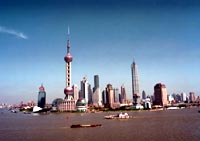 |
Top Destinations |
|
|
|
 |
Travel Tools |
|
|
|
 |
|
|
Shanghai Transportation Guide
 The
city covered an area of only 636.18 square kilometers in 1949. By the
year 1958, after Shanghai took over 10 counties from Jiangsu Province
-- including Jiading, Baoshan, Shanghai, Songjiang, Jinshan, Chuansha,
Nanhui, Fengxian, Qingpu and Chongming, the area under the city's jurisdiction
expanded to 5,910 square kilometers. The city had a total area of 6,340.5
square kilometers at the end of 2000, 0.06% of China's total territory.
The city extends about 120 kilometers in north and south and nearly 100
kilometers in east and west. Shanghai has an urban area of 3,924.24 square
kilometers and rural area of 2,416.26 square kilometers. Its land area
covers 6,219 square kilometers and water area runs 122 square kilometers.
The city's Chongming Island is the third largest island in China, covering
an area of 1,041 square kilometers. The
city covered an area of only 636.18 square kilometers in 1949. By the
year 1958, after Shanghai took over 10 counties from Jiangsu Province
-- including Jiading, Baoshan, Shanghai, Songjiang, Jinshan, Chuansha,
Nanhui, Fengxian, Qingpu and Chongming, the area under the city's jurisdiction
expanded to 5,910 square kilometers. The city had a total area of 6,340.5
square kilometers at the end of 2000, 0.06% of China's total territory.
The city extends about 120 kilometers in north and south and nearly 100
kilometers in east and west. Shanghai has an urban area of 3,924.24 square
kilometers and rural area of 2,416.26 square kilometers. Its land area
covers 6,219 square kilometers and water area runs 122 square kilometers.
The city's Chongming Island is the third largest island in China, covering
an area of 1,041 square kilometers.
Aviation: Shanghai now possesses two international airports, i.e.
Hongqiao International Airport in the west and Pudong International Airport
on the seashore of East China Sea. At present, the annual passenger handling
capacity of the two airports amounts to 16.4 million. When all the four
runways are completed in Pudong, Shanghai's annual air passenger handling
capacity will hit 100 million.
Railway: There are around 100 special railway lines in Shanghai
and it will establish a international multimode container network with
express through train as the mainstay, linking Hongkong and Macao to the
south, Russia and Europe to the north, connecting overseas to the east
and reaching Mid-Asia to the west.
 Port:
Shanghai Port is the largest port in Mainland China, covering an area
of 3,600 km*m. Starting from 1980s, Shanghai Port has become a world-class
port with a handling capacity of 100 million tons. Through the construction
of Waigaoqiao Wharf and No.5 Trough Project and reconstruction and functional
switch of part of the old wharves along the riverside of Huangpu River,
Shanghai Port will turn into an inter-continental hub port for container
transportation. Shipping: Shanghai has already established shipping business
links with more than 1,100 ports in more than 200 countries and regions
in the world. In terms of oceangoing lines, you can reach various destinations
inctuding Hongkong, Taiwan (via a third place), R.O.K., Japan, Southeast
Asia, Australia, Israel, Mediterranean, Northwest Europe, South Africa,
South America and East and West Coasts of U.S.A., etc., in terms of coastal
lines, you can reach the major harbors along the coast from north to south;
in terms of the Yangtze River lines, you can directly reach the ports
along the mid and downstream of Yangtze River; in terms of the inland
water transportation, you can reach the big and small ports and harbors
of Jiangsu, Zhejiang and Anhui Provinces via the waterway network in the
south of Yangtze River Basin. Port:
Shanghai Port is the largest port in Mainland China, covering an area
of 3,600 km*m. Starting from 1980s, Shanghai Port has become a world-class
port with a handling capacity of 100 million tons. Through the construction
of Waigaoqiao Wharf and No.5 Trough Project and reconstruction and functional
switch of part of the old wharves along the riverside of Huangpu River,
Shanghai Port will turn into an inter-continental hub port for container
transportation. Shipping: Shanghai has already established shipping business
links with more than 1,100 ports in more than 200 countries and regions
in the world. In terms of oceangoing lines, you can reach various destinations
inctuding Hongkong, Taiwan (via a third place), R.O.K., Japan, Southeast
Asia, Australia, Israel, Mediterranean, Northwest Europe, South Africa,
South America and East and West Coasts of U.S.A., etc., in terms of coastal
lines, you can reach the major harbors along the coast from north to south;
in terms of the Yangtze River lines, you can directly reach the ports
along the mid and downstream of Yangtze River; in terms of the inland
water transportation, you can reach the big and small ports and harbors
of Jiangsu, Zhejiang and Anhui Provinces via the waterway network in the
south of Yangtze River Basin.
|
|
 |
Travel
Guides |
|
|
 |
|

